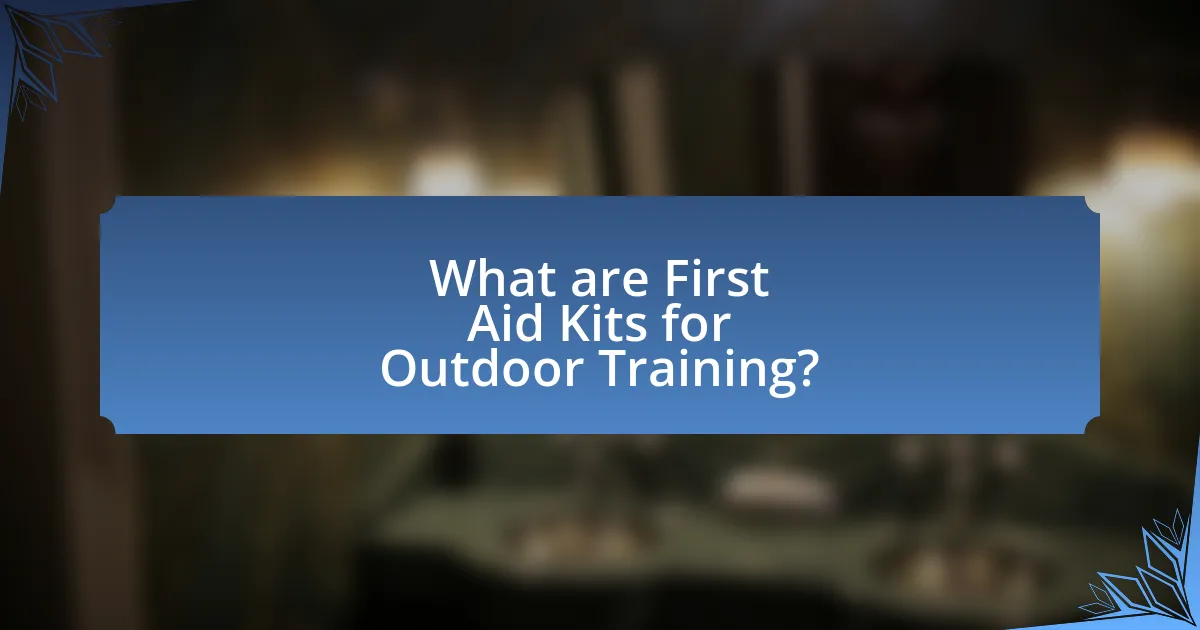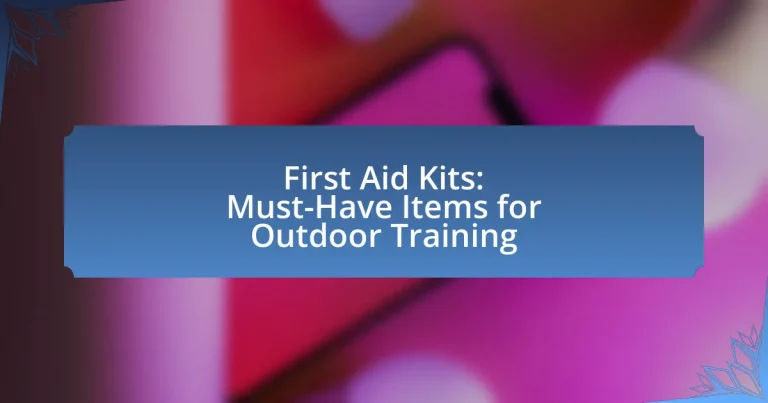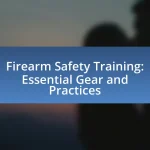First Aid Kits for Outdoor Training are essential collections of medical supplies designed to address injuries and emergencies during outdoor activities. These kits typically include items such as adhesive bandages, antiseptic wipes, gauze pads, and pain relievers, which are crucial for treating common injuries like cuts, scrapes, and sprains. The article outlines the importance of having a well-stocked First Aid Kit, the types of injuries that can occur, and the key components necessary for effective emergency response. It also discusses best practices for maintaining and using First Aid Kits, as well as how to tailor them to specific outdoor activities to enhance safety and preparedness.

What are First Aid Kits for Outdoor Training?
First Aid Kits for Outdoor Training are essential collections of medical supplies and equipment designed to address injuries and emergencies that may occur during outdoor activities. These kits typically include items such as adhesive bandages, antiseptic wipes, gauze pads, and pain relievers, which are crucial for treating common injuries like cuts, scrapes, and sprains. The inclusion of these supplies is supported by guidelines from organizations like the American Red Cross, which emphasizes the importance of being prepared for potential health issues in outdoor settings.
Why are First Aid Kits essential for outdoor training?
First Aid Kits are essential for outdoor training because they provide immediate medical assistance in case of injuries or emergencies. Outdoor environments often present risks such as cuts, scrapes, insect bites, and allergic reactions, which can occur unexpectedly. Having a First Aid Kit readily available ensures that participants can receive prompt treatment, potentially preventing complications or worsening of injuries. According to the American Red Cross, being prepared with a First Aid Kit can significantly reduce the severity of injuries and improve recovery outcomes in outdoor settings.
What types of injuries can occur during outdoor training?
During outdoor training, common types of injuries include sprains, strains, fractures, cuts, and abrasions. Sprains and strains often occur due to sudden movements or improper techniques, while fractures can result from falls or impacts. Cuts and abrasions typically happen from contact with sharp objects or rough terrain. According to the American Academy of Orthopaedic Surgeons, sprains and strains account for a significant percentage of sports-related injuries, highlighting the importance of preparedness in outdoor training scenarios.
How can First Aid Kits mitigate risks associated with outdoor activities?
First Aid Kits mitigate risks associated with outdoor activities by providing essential medical supplies and tools for immediate response to injuries or emergencies. These kits typically include items such as bandages, antiseptics, and pain relievers, which enable individuals to treat minor wounds and prevent infections on-site. According to the American Red Cross, having a well-stocked First Aid Kit can significantly reduce the severity of injuries by allowing for prompt treatment, which is crucial in remote outdoor settings where professional medical help may be far away. Additionally, First Aid Kits often contain instructional materials that guide users in administering first aid, further enhancing safety during outdoor activities.
What are the key components of a First Aid Kit for outdoor training?
The key components of a First Aid Kit for outdoor training include adhesive bandages, antiseptic wipes, gauze pads, adhesive tape, scissors, tweezers, a CPR face shield, and a first aid manual. These items are essential for treating minor injuries and preventing infections during outdoor activities. For instance, adhesive bandages and gauze pads are crucial for covering cuts and abrasions, while antiseptic wipes help to clean wounds. Scissors and tweezers assist in removing splinters or cutting tape, and a CPR face shield is vital for performing resuscitation safely. A first aid manual provides guidance on how to handle various medical situations, ensuring preparedness in emergencies.
What basic supplies should every First Aid Kit include?
Every First Aid Kit should include adhesive bandages, antiseptic wipes, gauze pads, adhesive tape, scissors, tweezers, and a CPR face shield. These items are essential for treating minor injuries and preventing infections. For instance, adhesive bandages protect cuts and scrapes, while antiseptic wipes clean wounds to reduce the risk of infection. Gauze pads and adhesive tape are crucial for dressing larger wounds, and scissors and tweezers assist in removing splinters or cutting tape. A CPR face shield is vital for providing safe rescue breaths in emergencies.
How do specialized items enhance the effectiveness of a First Aid Kit?
Specialized items enhance the effectiveness of a First Aid Kit by providing targeted solutions for specific injuries and emergencies. For instance, items like splints, burn dressings, and tourniquets are designed to address particular medical situations, ensuring that responders can manage injuries more effectively and efficiently. Research indicates that having specialized tools can significantly reduce the time to treat injuries, which is critical in outdoor training scenarios where immediate medical assistance may not be available. Furthermore, studies show that kits containing these specialized items improve the confidence and preparedness of individuals, leading to better outcomes in emergency situations.
How do you choose the right First Aid Kit for outdoor training?
To choose the right First Aid Kit for outdoor training, assess the specific activities and potential injuries associated with those activities. For instance, if training involves hiking or climbing, select a kit that includes items for treating cuts, scrapes, sprains, and insect bites, as these are common in such environments.
Additionally, ensure the kit contains essential supplies such as adhesive bandages, antiseptic wipes, gauze pads, and a first aid manual. According to the American Red Cross, a well-stocked kit should also include items like a CPR face shield, scissors, and tweezers, which are crucial for effective emergency response.
Finally, consider the size and weight of the kit, as it should be portable and easy to carry during outdoor activities. A compact kit that meets these criteria will enhance safety and preparedness during outdoor training sessions.
What factors should be considered when selecting a First Aid Kit?
When selecting a First Aid Kit, consider the specific needs of the environment and activities it will be used for. Factors include the types of injuries likely to occur, the number of people it will serve, and the duration of the outdoor training. For instance, a kit for hiking may require more supplies for cuts and insect bites, while a kit for a multi-day camping trip should include items for more serious injuries and illnesses. Additionally, ensure the kit is compact, waterproof, and contains essential items like bandages, antiseptics, and pain relievers. According to the American Red Cross, a well-stocked First Aid Kit can significantly improve response times and outcomes in emergencies.
How does the size and weight of a First Aid Kit impact its usability?
The size and weight of a First Aid Kit significantly impact its usability by influencing portability and accessibility. A compact and lightweight kit is easier to carry during outdoor activities, ensuring that individuals can quickly access medical supplies when needed. Research indicates that users are more likely to carry a smaller kit, which increases the likelihood of having essential items available in emergencies. For instance, a study published in the Journal of Wilderness Medicine found that participants preferred kits weighing less than two pounds for hiking, as they balanced the need for comprehensive supplies with ease of transport. Thus, the usability of a First Aid Kit is directly enhanced by its size and weight, making it more practical for outdoor training scenarios.

What are the best practices for using First Aid Kits in outdoor training?
The best practices for using First Aid Kits in outdoor training include ensuring the kit is easily accessible, regularly checking and restocking supplies, and training participants in basic first aid procedures. Accessibility is crucial; the kit should be stored in a known location that is easy to reach during emergencies. Regular checks, ideally before each training session, help maintain the kit’s effectiveness by replacing expired items and ensuring all necessary supplies are present. Training participants in basic first aid, such as how to treat cuts, sprains, and allergic reactions, empowers them to respond effectively in emergencies, enhancing safety during outdoor activities. These practices are supported by guidelines from organizations like the American Red Cross, which emphasize preparedness and knowledge in first aid situations.
How should you prepare for emergencies during outdoor training?
To prepare for emergencies during outdoor training, individuals should assemble a comprehensive first aid kit tailored to specific activities and potential risks. This kit must include essential items such as adhesive bandages, antiseptic wipes, gauze pads, adhesive tape, scissors, tweezers, and a CPR face shield. According to the American Red Cross, having a well-stocked first aid kit can significantly improve response times and outcomes in emergencies, as it allows for immediate treatment of injuries. Additionally, participants should familiarize themselves with the contents of the kit and basic first aid procedures to ensure effective use during an emergency.
What training is recommended for effective First Aid Kit usage?
Recommended training for effective First Aid Kit usage includes completing a certified First Aid and CPR course. These courses, often provided by organizations such as the American Red Cross or St. John Ambulance, equip individuals with essential skills to assess emergencies, perform CPR, and utilize the items in a First Aid Kit effectively. Statistics show that trained individuals are significantly more likely to provide effective assistance in emergencies, enhancing survival rates and outcomes.
How can you ensure your First Aid Kit is always ready for use?
To ensure your First Aid Kit is always ready for use, regularly check and restock its contents. This involves conducting a monthly inventory to verify that all items are present, functional, and within their expiration dates. For instance, adhesive bandages, antiseptic wipes, and medications like aspirin should be replaced as needed to maintain effectiveness. According to the American Red Cross, a well-maintained First Aid Kit can significantly improve response times and outcomes in emergencies, highlighting the importance of preparedness.
What common mistakes should be avoided when using First Aid Kits?
Common mistakes to avoid when using First Aid Kits include not checking the kit’s contents regularly, using expired supplies, and failing to follow proper procedures for specific injuries. Regularly checking ensures that all necessary items are available and in good condition, as studies show that many kits are often understocked or contain outdated materials. Using expired supplies can lead to ineffective treatment, as medications and sterile items may lose their potency or safety over time. Additionally, not adhering to established first aid protocols can result in worsening the injury or delaying appropriate medical care, which is critical in emergency situations.
Why is it important to regularly check and restock your First Aid Kit?
Regularly checking and restocking your First Aid Kit is crucial to ensure that all necessary supplies are available and effective during emergencies. Over time, items can expire, become damaged, or be used, leading to a kit that lacks essential components when needed most. For instance, a study by the American Red Cross highlights that 70% of people do not have a fully stocked First Aid Kit, which can significantly hinder response times in critical situations. Therefore, maintaining an updated kit not only enhances safety but also increases the likelihood of effectively addressing injuries or medical emergencies during outdoor training activities.
How can improper use of a First Aid Kit worsen a situation?
Improper use of a First Aid Kit can worsen a situation by causing further injury or complications. For instance, applying the wrong type of bandage to a wound can lead to infection or delayed healing. Additionally, using expired medications from the kit may not provide the necessary treatment, potentially exacerbating the medical issue. Studies indicate that incorrect first aid practices can increase recovery time and lead to more severe health outcomes, emphasizing the importance of proper training in first aid techniques.

What are the specific items to include in a First Aid Kit for outdoor training?
A First Aid Kit for outdoor training should include adhesive bandages, sterile gauze pads, adhesive tape, antiseptic wipes, tweezers, scissors, a CPR face shield, a first aid manual, pain relievers, and a triangular bandage. These items are essential for treating common injuries such as cuts, scrapes, sprains, and allergic reactions, ensuring that participants can receive immediate care in outdoor settings. The inclusion of these specific items is supported by guidelines from organizations like the American Red Cross, which emphasizes the importance of being prepared for emergencies during outdoor activities.
What are the must-have items for treating cuts and scrapes?
The must-have items for treating cuts and scrapes include antiseptic wipes, adhesive bandages, sterile gauze pads, medical tape, and antibiotic ointment. Antiseptic wipes clean the wound to prevent infection, while adhesive bandages protect the area from dirt and bacteria. Sterile gauze pads absorb any bleeding, and medical tape secures the gauze in place. Antibiotic ointment promotes healing and further reduces the risk of infection. These items are essential for effective first aid in outdoor training scenarios, ensuring proper wound care and minimizing complications.
How do antiseptics and bandages play a role in wound care?
Antiseptics and bandages are essential components of wound care, as they help prevent infection and promote healing. Antiseptics, such as alcohol or iodine solutions, kill or inhibit the growth of pathogens on the wound surface, reducing the risk of infection. Bandages protect the wound from external contaminants and provide a moist environment that is conducive to healing. Studies show that maintaining a moist wound environment can accelerate healing by up to 50% compared to dry conditions. Together, antiseptics and bandages form a critical barrier against infection while facilitating the body’s natural healing processes.
What additional supplies are useful for more serious injuries?
For more serious injuries, additional supplies such as a tourniquet, hemostatic dressings, and a splint are essential. A tourniquet effectively controls severe bleeding by applying pressure to a limb, while hemostatic dressings promote rapid clotting to stop blood loss. Splints stabilize fractures or dislocations, preventing further injury during transport. These items are critical in emergency situations, as they enhance the ability to manage life-threatening conditions until professional medical help arrives.
What items are essential for managing allergic reactions and bites?
Essential items for managing allergic reactions and bites include antihistamines, epinephrine auto-injectors, hydrocortisone cream, and ice packs. Antihistamines, such as diphenhydramine, help alleviate symptoms of allergic reactions, while epinephrine auto-injectors are critical for severe allergic reactions, known as anaphylaxis, providing immediate treatment. Hydrocortisone cream reduces inflammation and itching from insect bites, and ice packs can help minimize swelling and pain. These items are widely recommended by health organizations, including the American Academy of Allergy, Asthma & Immunology, as crucial components of first aid kits for outdoor activities.
How can antihistamines and epinephrine auto-injectors be included in a First Aid Kit?
Antihistamines and epinephrine auto-injectors can be included in a First Aid Kit by ensuring they are stored in a clearly labeled, easily accessible compartment. Antihistamines, such as diphenhydramine, can help alleviate allergic reactions, while epinephrine auto-injectors are crucial for treating severe anaphylaxis. It is essential to check expiration dates regularly and replace any expired medications to maintain effectiveness. Additionally, including instructions for use with the auto-injector can enhance preparedness in emergency situations.
What preventive measures can be taken against insect bites and stings?
Preventive measures against insect bites and stings include wearing protective clothing, using insect repellent, and avoiding areas with high insect activity. Protective clothing, such as long sleeves and pants, minimizes skin exposure, while insect repellents containing DEET or picaridin effectively deter insects. Additionally, staying away from stagnant water and dense vegetation reduces the likelihood of encounters with insects. Studies show that using repellents can decrease the risk of bites by up to 90%, highlighting their effectiveness in outdoor settings.
What are the best tips for maintaining an effective First Aid Kit?
To maintain an effective First Aid Kit, regularly check and restock supplies, ensuring all items are within their expiration dates. This practice is crucial because expired medications and supplies can be ineffective in emergencies. Additionally, customize the kit based on specific activities and potential risks associated with outdoor training, such as including items for treating insect bites or sunburns. Keeping the kit organized and easily accessible enhances response time during emergencies, which is vital for effective first aid. Regularly reviewing the kit’s contents and updating it after each use ensures that it remains prepared for any situation.
How often should you review and update your First Aid Kit contents?
You should review and update your First Aid Kit contents at least every six months. Regular reviews ensure that items are not expired, damaged, or missing, which is crucial for effective emergency response. According to the American Red Cross, checking your kit biannually helps maintain readiness and ensures that all necessary supplies are available when needed.
What strategies can help ensure your First Aid Kit is tailored to specific outdoor activities?
To ensure your First Aid Kit is tailored to specific outdoor activities, assess the unique risks associated with each activity and include relevant supplies. For instance, hiking may require items for blisters and insect bites, while camping might necessitate additional supplies for burns and allergic reactions. Research indicates that customizing first aid kits based on activity type significantly enhances preparedness; a study by the American Red Cross highlights that 70% of outdoor injuries can be effectively managed with appropriate first aid supplies. Therefore, regularly review and update your kit based on the specific outdoor environment and potential hazards you may encounter.


